An Integrated Model Based on a Hierarchical Indices System for Monitoring and Evaluating Urban Sustainability
Abstract
:1. Introduction
2. Current Challenges and Opportunities in the Development of USI Models
2.1. Development of Urban Sustainability Indicator (USI) Models
2.2. Problems and Opportunities in Current USI Models
3. Important Domains of Urban Sustainability Evaluation
3.1. Urbanization
3.1.1. Population Growth
3.1.2. Urban Sprawl and Land Cover/Land Use Change
3.2. Urban Environment
3.2.1. Green Space (GS)
3.2.2. Water Quantity and Quality
3.2.3. Impervious Surface Area (ISA)
3.2.4. Urban Surface Temperature
3.3. QOL
3.3.1. Definition of QOL
3.3.2. Sustainable Implications of QOL
4. Availability of Potential Approaches
4.1. Urban Expansion and Land Use Change
4.2. Urban Environment Detection
4.2.1. Mapping Vegetation
4.2.2. Mapping Impervious Area
4.2.3. Urban Water Quality
4.2.4. Urban Surface Temperature
4.3. QOL Assessment
4.4. Opportunities in Available Methodologies
5. A Potential Integrated Model for Evaluating Urban Sustainability
5.1. Define a Suitable Interpretation of Urban Sustainability
5.2. Establish the Framework of the Integrated USI Model
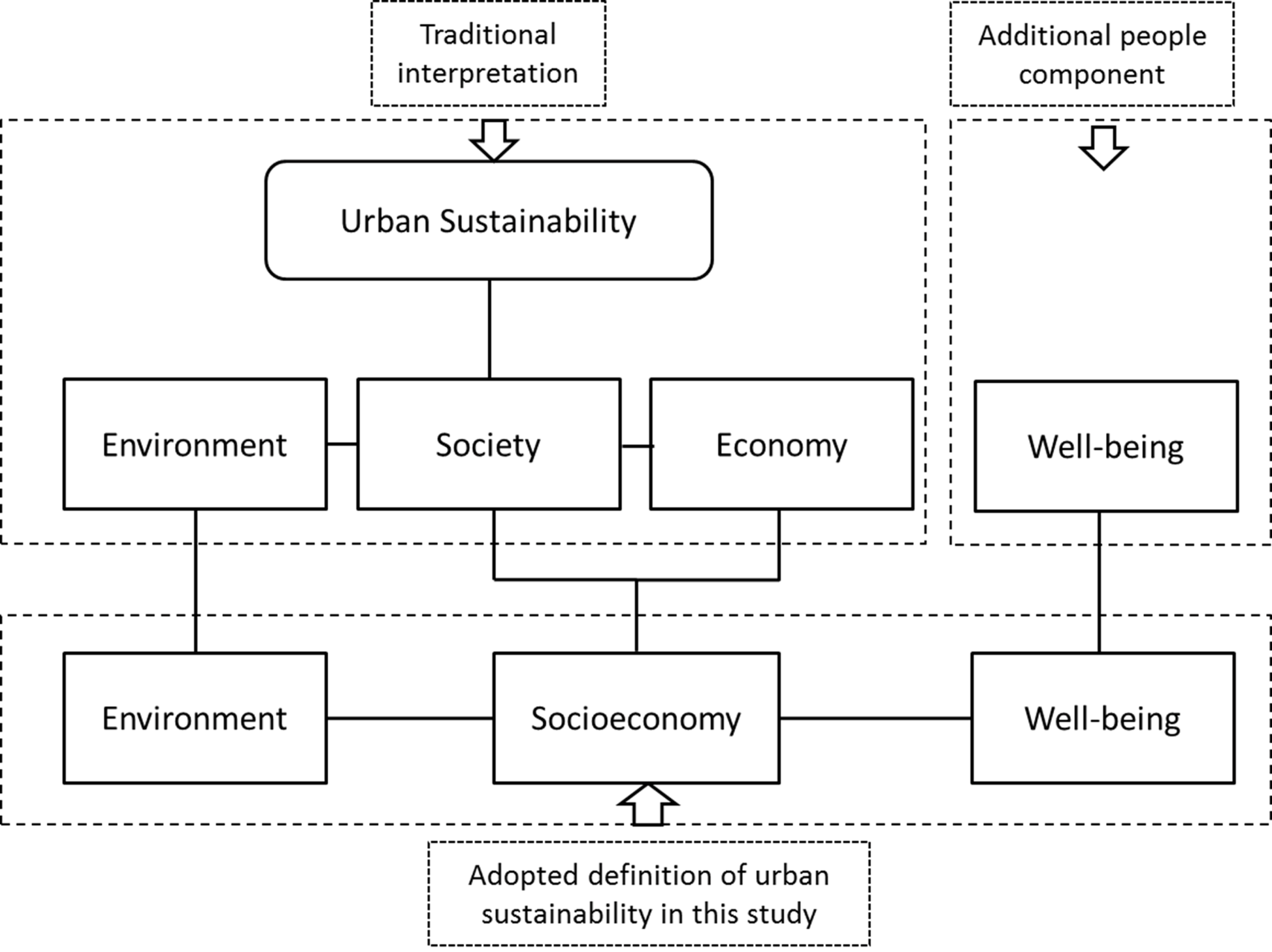
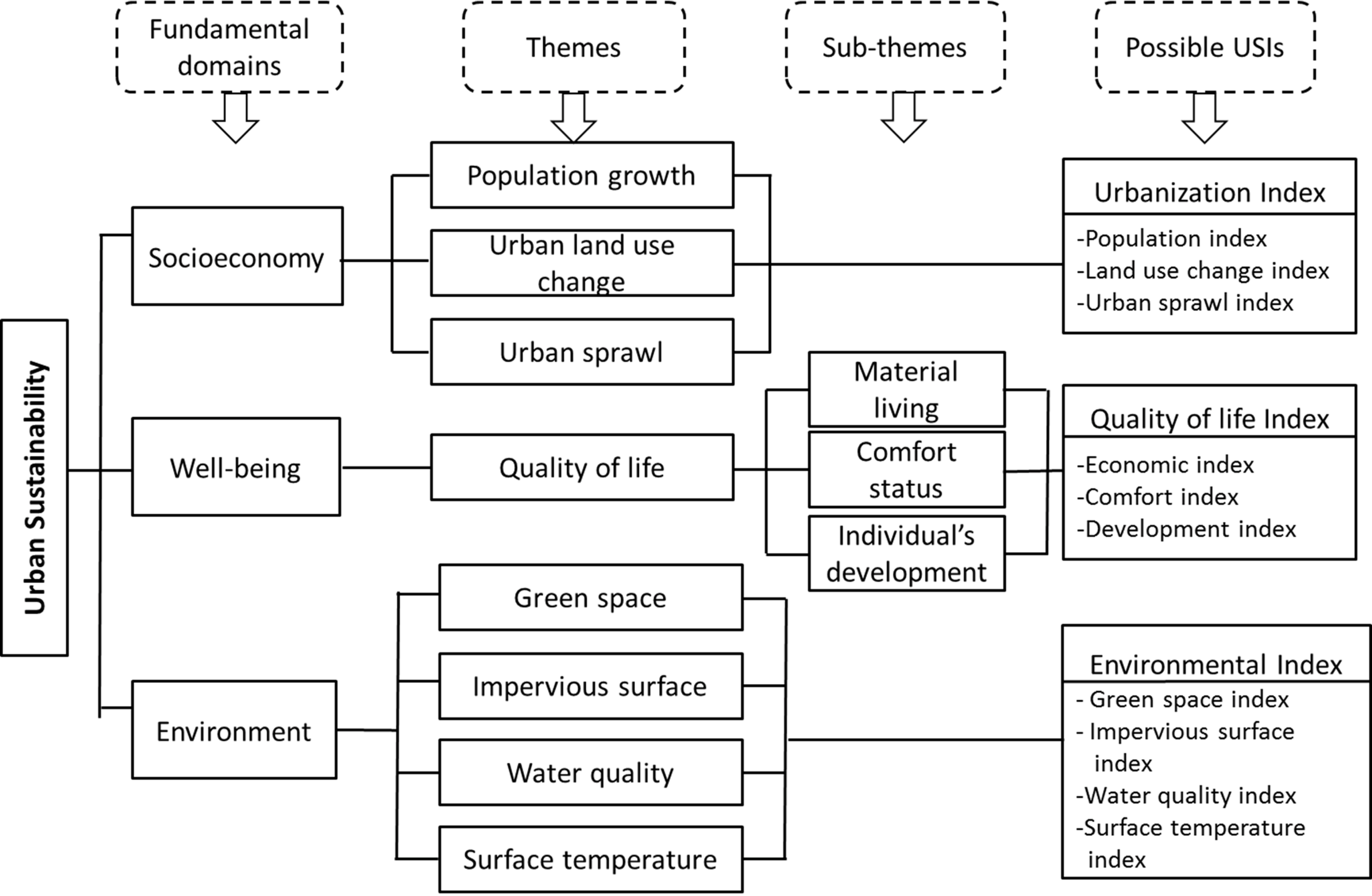
5.3. Identify Preliminary Indicators and Measurements for the USI Model

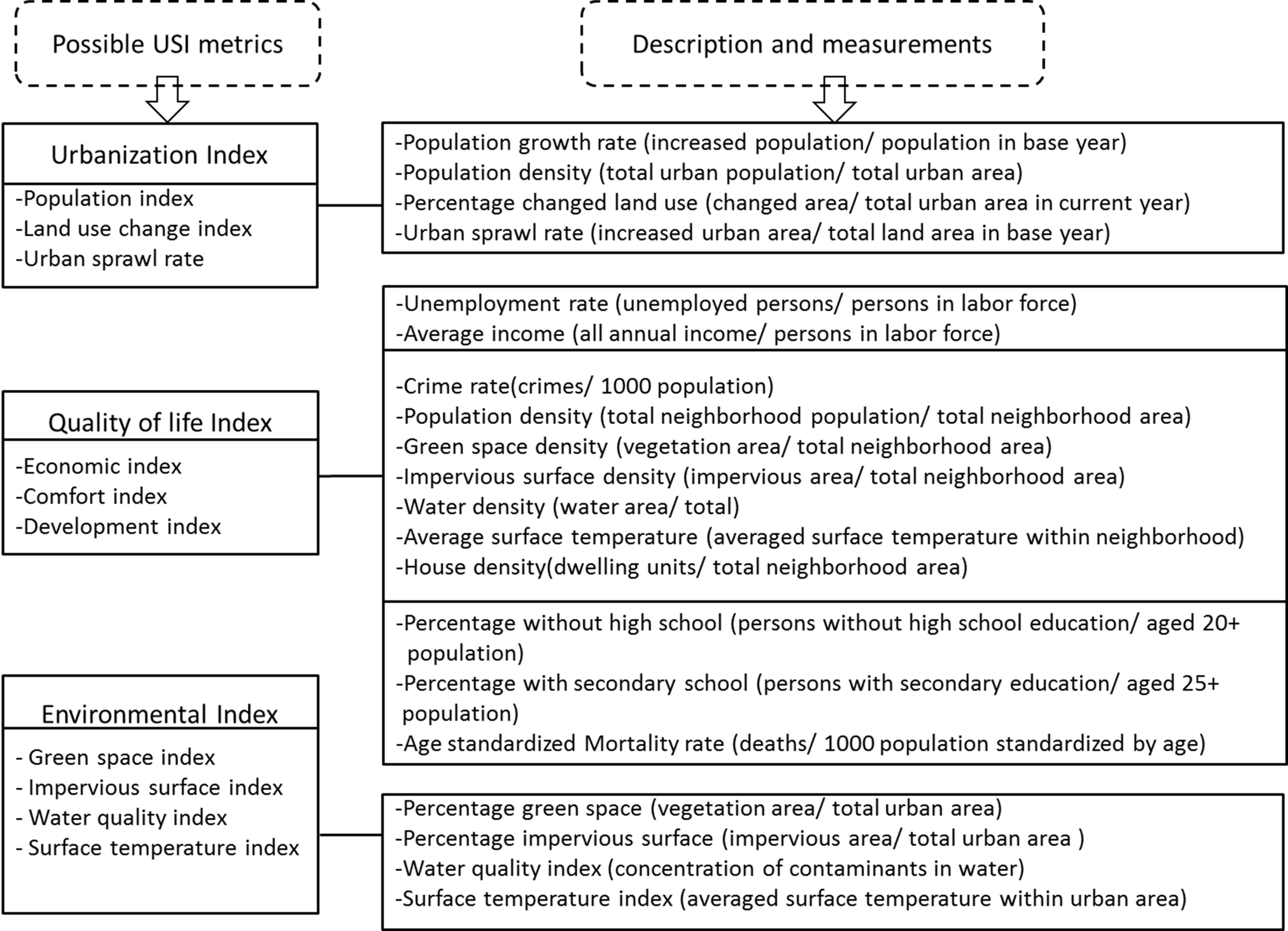
5.4. Indicator Evaluation and Determination
5.5. A Preliminary Case Study of the Proposed Model
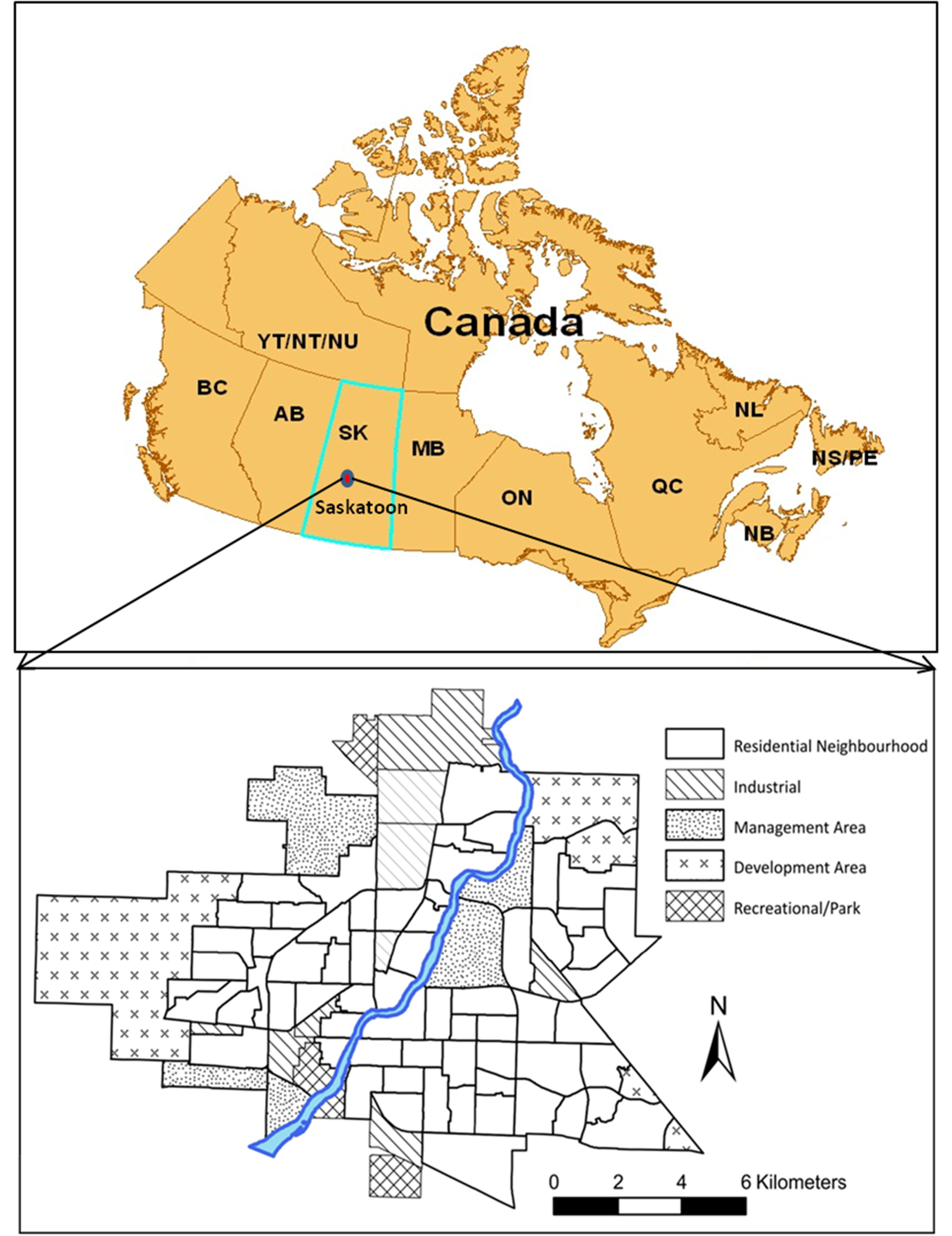
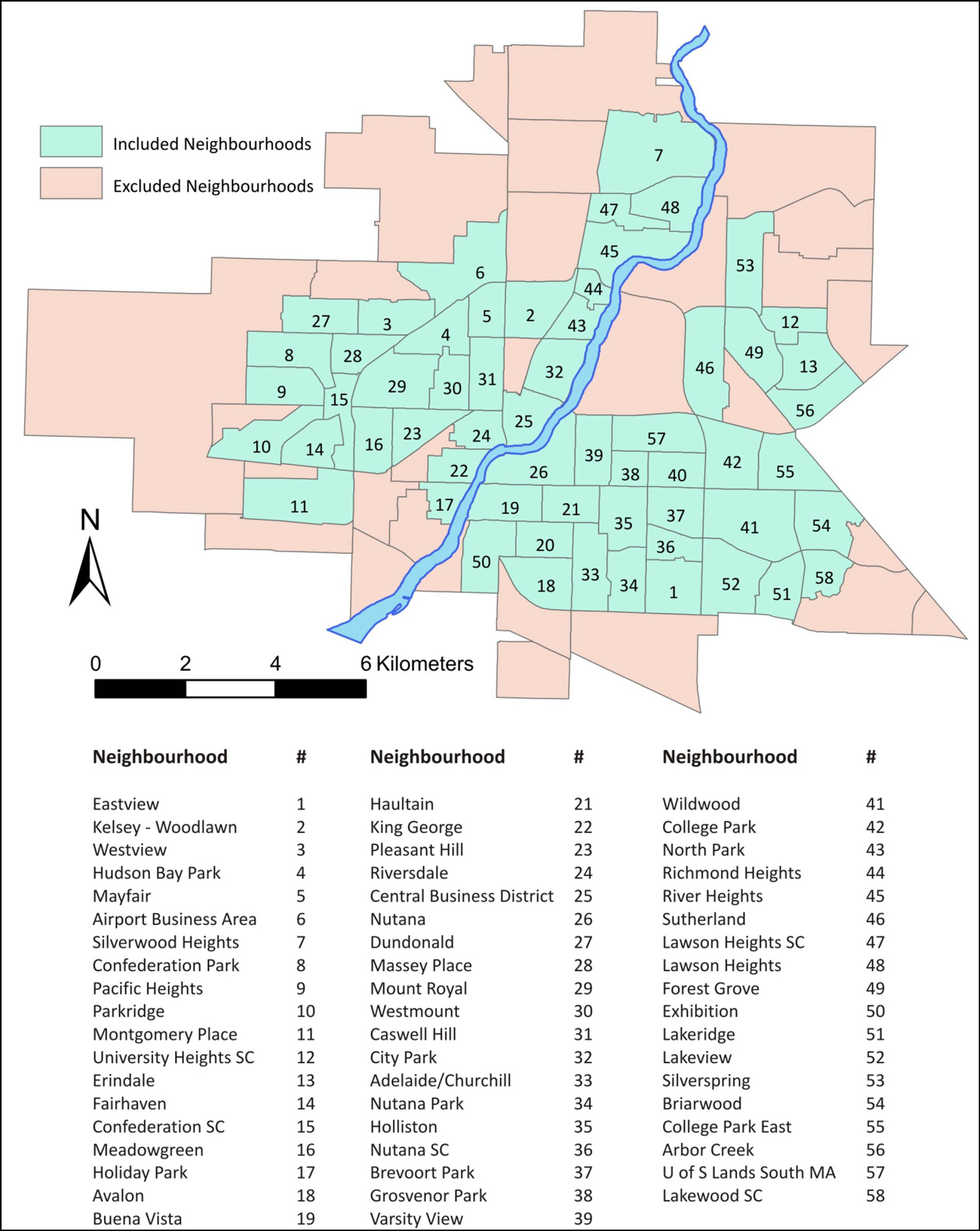
| Neighbourhood | Subjectively Weighted QOL index | Neighbourhood | Subjectively Weighted QOL Score |
|---|---|---|---|
| Adelaide/Churchill | 132.31 | Lakeview | 126.58 |
| Airport Business Area | 88.43 | Lakewood SC | 137.11 |
| Arbor Creek | 130.56 | Lawson Heights | 126.64 |
| Avalon | 130.06 | Lawson Heights SC | 125.79 |
| Brevoort Park | 123.12 | Massey Place | 110.36 |
| Briarwood | 130.50 | Mayfair | 105.27 |
| Buena Vista | 126.01 | Meadowgreen | 107.57 |
| Caswell Hill | 109.05 | Montgomery Place | 130.24 |
| Central Business District | 92.29 | Mount Royal | 112.05 |
| City Park | 120.27 | North Park | 121.32 |
| College Park | 117.57 | Nutana | 124.03 |
| College Park East | 126.57 | Nutana Park | 132.85 |
| Confederation Park | 109.29 | Nutana SC | 117.72 |
| Confederation SC | 95.73 | Pacific Heights | 116.35 |
| Dundonald | 119.55 | Parkridge | 117.70 |
| Eastview | 127.22 | Pleasant Hill | 81.27 |
| Erindale | 129.45 | Queen Elizabeth | 128.21 |
| Exhibition | 115.32 | Richmond Heights | 127.57 |
| Fairhaven | 112.65 | River Heights | 130.47 |
| Forest Grove | 121.40 | Riversdale | 73.24 |
| Greystone Heights | 128.70 | Silverspring | 129.18 |
| Grosvenor Park | 125.52 | Silverwood Heights | 129.41 |
| Haultain | 120.72 | Sutherland | 117.61 |
| Holiday Park | 115.64 | U of S Lands South MA | 111.55 |
| Holliston | 126.59 | University Heights SC | 133.95 |
| Hudson Bay Park | 119.48 | Varsity View | 119.26 |
| Kelsey - Woodlawn | 100.55 | Westmount | 109.76 |
| King George | 109.30 | Westview | 123.39 |
| Lakeridge | 130.23 | Wildwood | 130.91 |
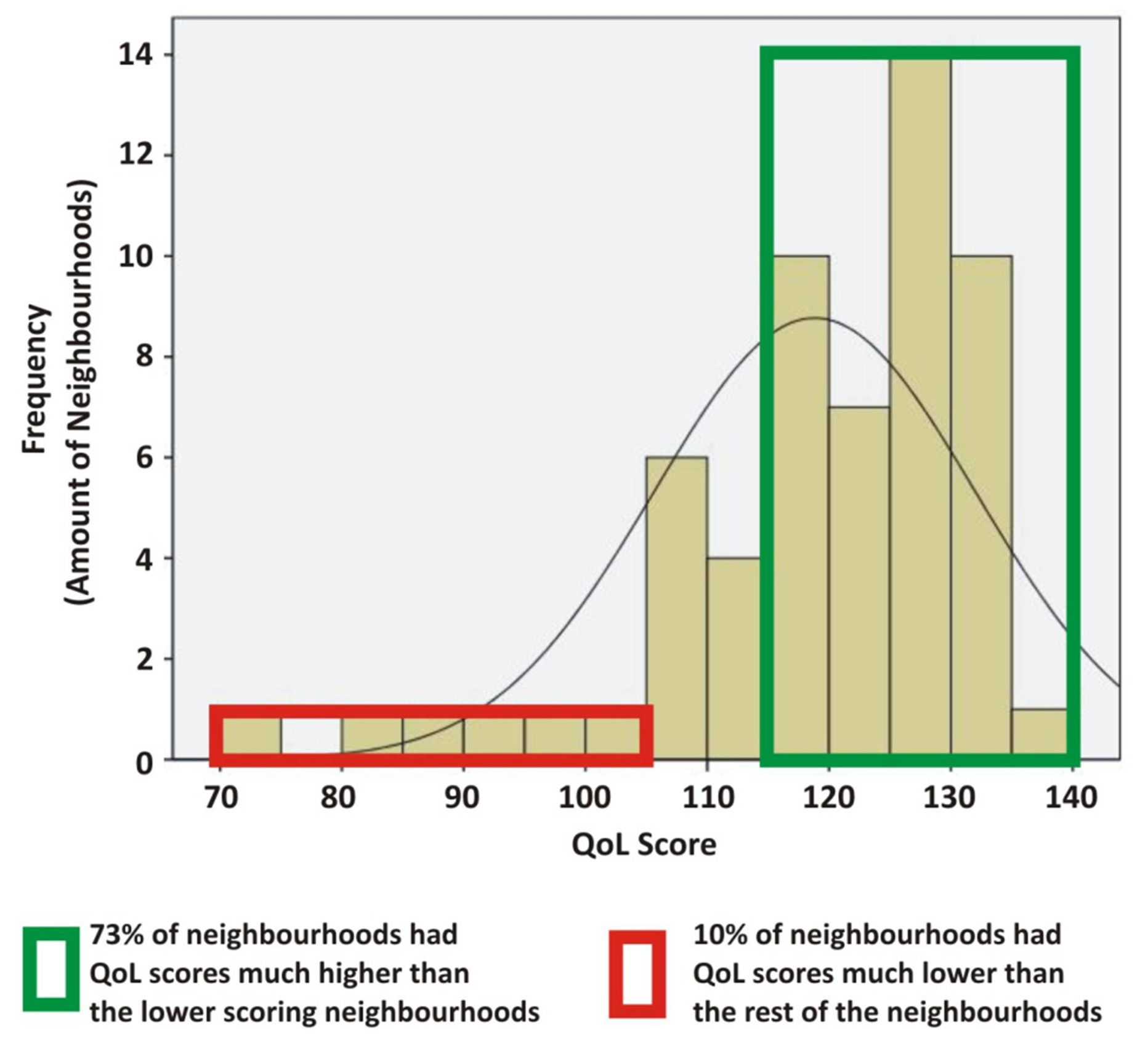
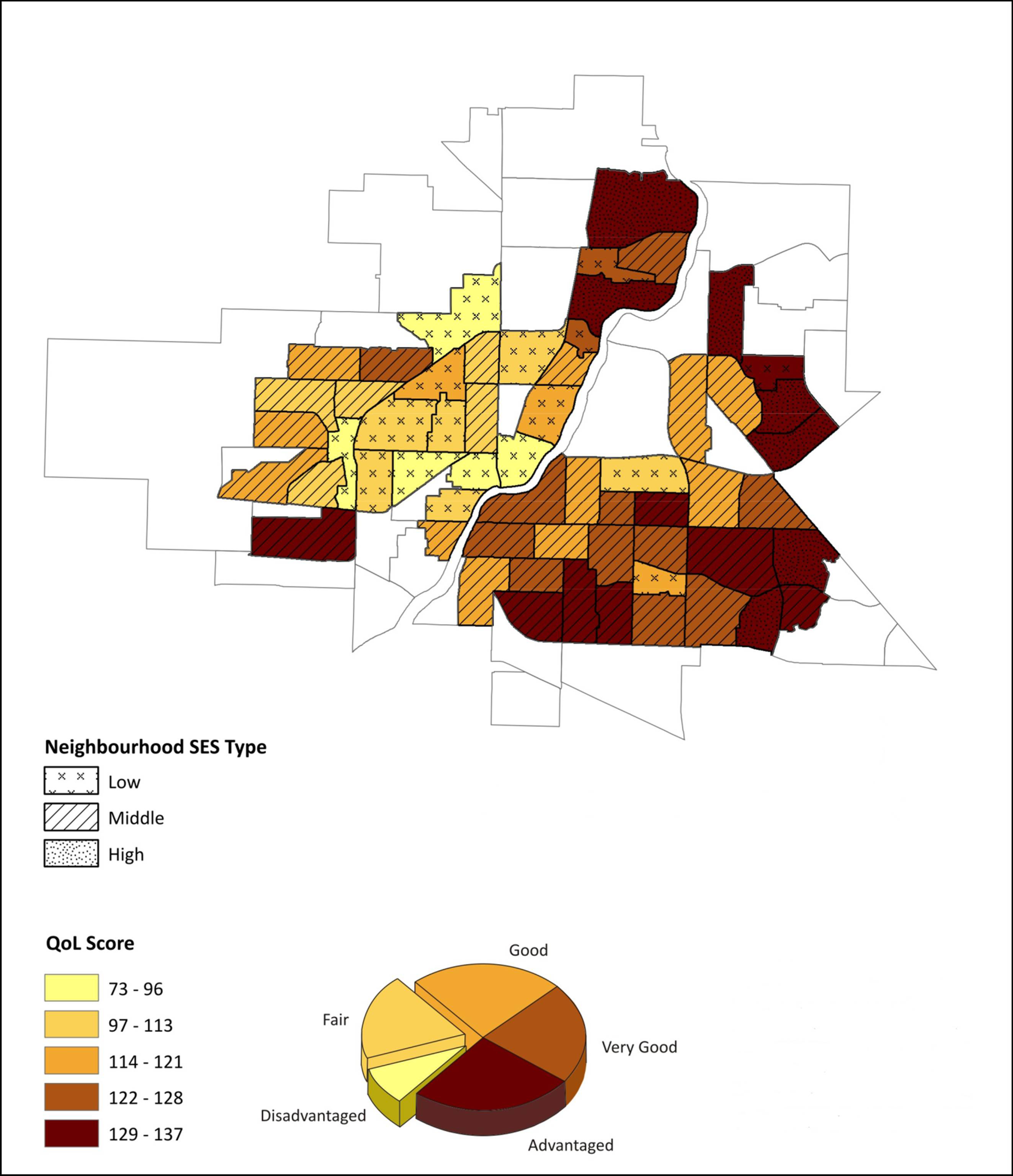
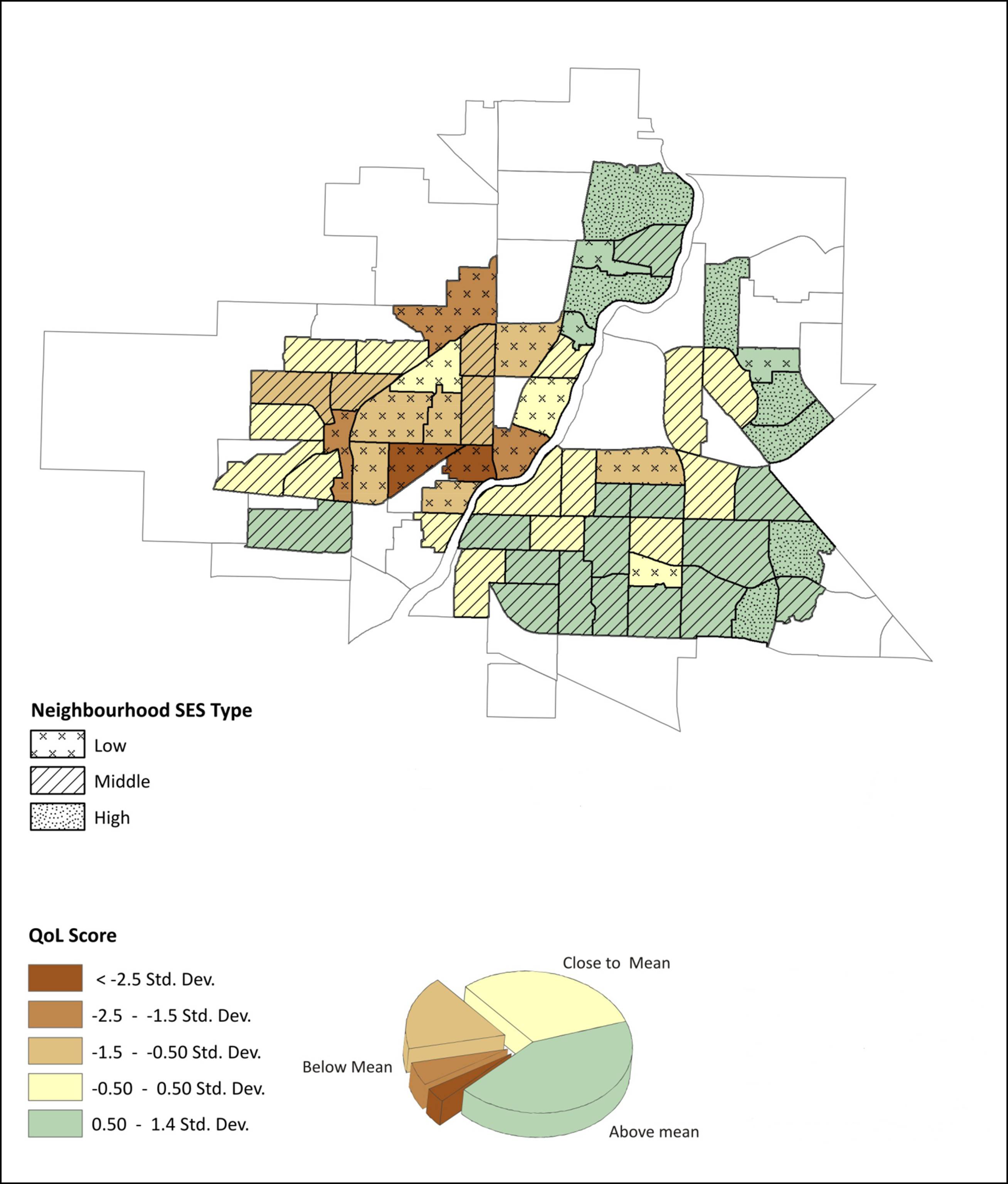
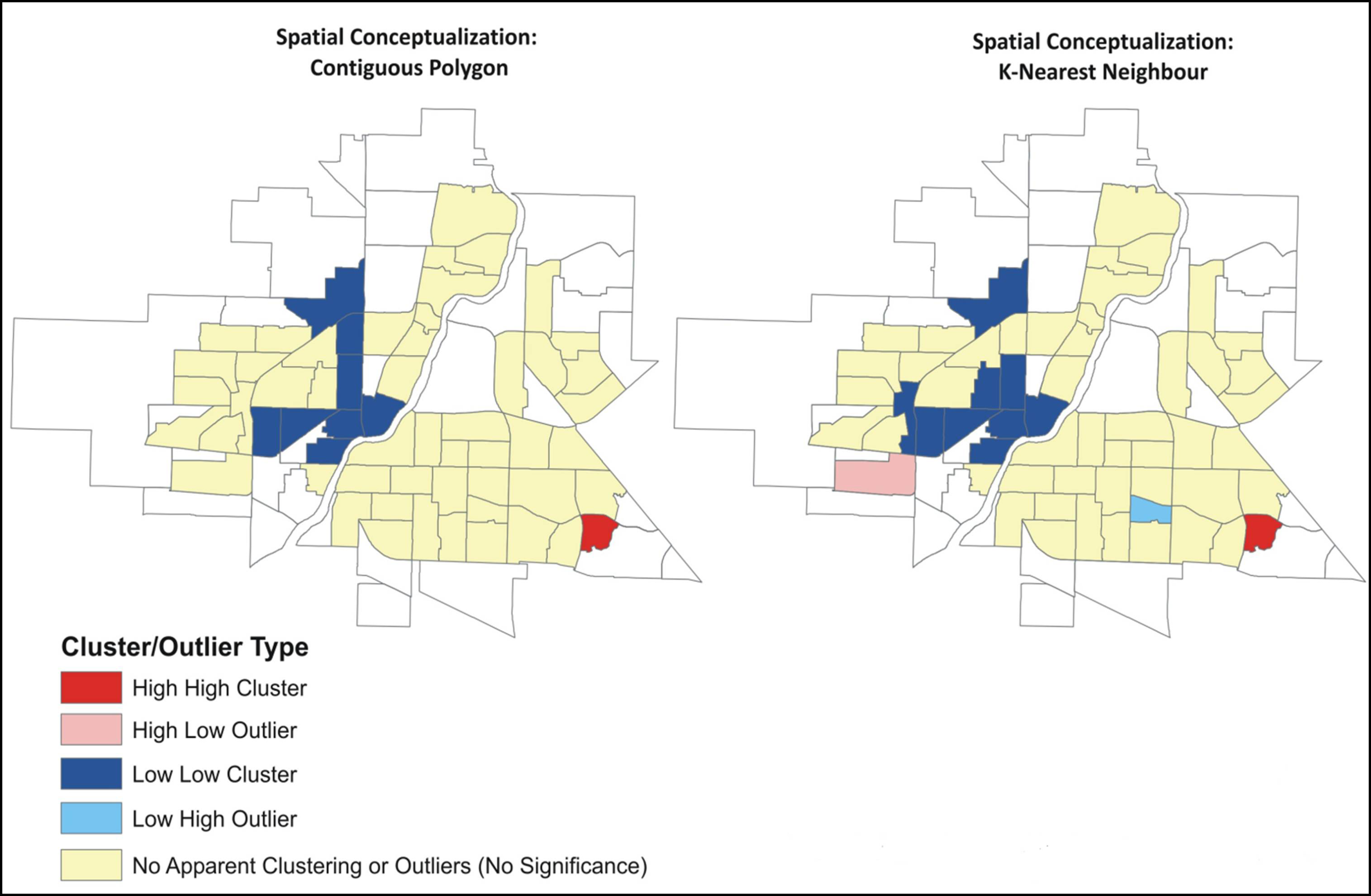

6. Discussion and Conclusions
Acknowledgments
Conflict of Interest
References and Notes
- UN. 2006. World Urbanization Prospects: the 2005 Revision Population Database. Available online: http://esa.un.org/unup/ (accessed on 15 June 2012).
- UNFP (United Nations Population Fund). State of world population 1999. United Nations Publications, New York. 1999. Available online: http://www.unfpa.org/swp/1999/contents.htm (accessed on 15 June 2012).
- Birch, E.L.; Wachter, S.M. Global Urbanization, Part 1. Twenty-First-Century Population Prospect: Emerging Needs; University of Pennsylvania Press: Philadelphia, PA, USA, 2011. [Google Scholar]
- McGranahan, G.; Marcotullio, P.J.; Bai, X.; Balk, D.; Braga, T.; Douglas, I.; Elmqvist, T.; Rees, W.; Satterthwaite, D.; Songsore, J.; et al. Urban Systems. Current State and Trends: Findings of the Condition and Trends Working Group. Ecosystems and Human Well-being; Island Press: Washington, DC, USA, 2005; pp. 795–825. [Google Scholar]
- Bruntland, G. Our Common Future: The World Commission on Environment and Development; Oxford University Press: New York, NY, USA, 1987. [Google Scholar]
- Nijkamp, P.; Perrels, A.H. Sustainable Cities in Europe, 1st ed; Earthscan: Sterling, London, UK, 2009. [Google Scholar]
- Sanders, J.C. Seattle and the Roots of Urban Sustainability: Inventing Ecotopia; University of Pittsburgh Press: Pittsburgh, PA, USA, 2010. [Google Scholar]
- Slavin, M.I. Sustainability in America's Cities: Creating the Green Metropolis; Island Press: Washington, DC, USA, 2011. [Google Scholar]
- Tamagawa, H. Sustainable Cities: Japanese Perspectives on Physical and Social Structures; United Nations University Press: Tokyo, Japan, 2006. [Google Scholar]
- Tsenkova, S. Urban Sustainability in Europe and North America: Challenges and Opportunities; University of Calgary: Calgary, AB, Canada, 2005. [Google Scholar]
- Newman, L. The virtuous cycle: incremental changes and a process-based sustainable development. Sustain. Dev. 2007, 15, 267–274. [Google Scholar]
- Mebratu, D. Sustainability and sustainable development: Historical and review. Environ. Impact. Assess. Rev. 1998, 18, 493–520. [Google Scholar]
- Maclaren, V.W. Developing Indicators of Urban Sustainability: A Focus on the Canadian Experience; ICURR Press: Toronto, Canada, 1996. [Google Scholar]
- Haughton, G. Environmental justice and the sustainable city. J. Plann. Educ. Res. 1999, 18, 233–243. [Google Scholar] [CrossRef]
- Alberti, M. Measuring urban sustainability. Environ. Impact Assess. Rev. 1996, 16, 381–424. [Google Scholar]
- British Columbia Commission on Resources and EnvironmentBritish Columbia Round Table on the Environment and the EconomyFraser Basin Management Board (Canada)State of Sustainability: Urban Sustainability and Containment; British Columbia Round Table on the Environment and the Economy: Victory, British Columbia, Canada, 1994.
- Næss, P. Urban planning and sustainable development. Eur. Plann. Stud. 2001, 9, 503–524. [Google Scholar]
- Hardoy, J.E.; Mitlin, D.; Satterwaite, D. Environmental Problems in Third World Cities; Earthscan: London, UK, 1992. [Google Scholar]
- Richardson, N.H. Land Use Planning and Sustainable Development in Canada; Canadian Environmental Advisory Council: Ottawa, Canada, 1989. [Google Scholar]
- Haughton, G.; Hunter, C. Sustainable Cities; Routledge: London, UK, 2003. [Google Scholar]
- Keirstead, J.; Leach, M. Bridging the gaps between theory and practice: A service niche approach to urban sustainability indicators. Sustain. Dev. 2008, 16, 329–340. [Google Scholar] [CrossRef]
- Huang, S.L.; Wong, J.H.; Chen, T. A framework of indicator system for measuring Taipei’s urban sustainability. Landsc. Urban. Plann. 1998, 42, 15–27. [Google Scholar] [CrossRef]
- Sustainable Seattle, Sustainable Seattle Indicators of Sustainable Community: A Report to Citizens on Long Term Trends in Their Community; Sustainable Seattle: Seattle, WA, USA, 1993.
- Local Government Management Board, Sustainability Indicators Research Project: Report of Phase 1, June 1994; Local Government Management Board: Luton, UK, 1994.
- Gosselin, P.; Belanger, D.; Bibeault, J.F.; Webster, A. Feasibility Study on the Development of Indicators for a Sustainability Society; Health and Welfare: Ottawa, Canada, 1991. [Google Scholar]
- Environment Canada, Environmental Indicator Selection Criteria; State of the Environment Directorate, Environment Canada: Ottawa, Canada, 1994.
- Maclaren, V.M. Urban sustainability reporting. J. Am. Plann. Assoc. 1996, 62, 184–202. [Google Scholar]
- Rossi, R.J.; Gilmartin, K.J. The Handbook of Social Indicators: Sources, Characteristics and Analysis; Graland STPM Press: New York, NY, USA, 1980. [Google Scholar]
- Carruthers, D.A. Urban Green Space Indicators Development; State of the Environment Reporting, Environment Canada: Ottawa, Canada, 1994. [Google Scholar]
- Regional Municipatiliy of Hamilton-Wentworth, Signposts on the Trail to Vision 2020: Sustainability Indicators for the Hamilton-Wentworth Region -Participants Workbook; Regional Municipality of Hamilton-Wentworth: Hamilton, Canada, 1995.
- Lee, Y.; Huang, C. Sustainability index for Taipei. Environ. Impact Assess Rev. 2007, 27, 505–521. [Google Scholar]
- London Sustainable Development Commission (LSDC). A sustainable development framework for London. Available online: http://www.london.gov.uk/mayor/sustainable-development/susdevcomm_framework.jsp (accessed on 10 May 2012).
- Cobb, C.W. Measuring tools and the QOL. Redefining Progress 2000, June, 1–31. [Google Scholar]
- Li, G.; Weng, Q. Measuring the QOL in city of Indianapolis by integration of remote sensing and census data. Int. J. Rem. Sens. 2007, 28, 249–267. [Google Scholar]
- Small, C. The Landsat ETM+ spectral mixing space. Rem. Sens. Environ. 2004, 93, 1–17. [Google Scholar]
- Jensen, R.; Gatrell, J.; Boulton, J.; Harper, B. Using remote sensing and geographic information systems to study urban QOL and urban forest amenities. Ecol. Soc. 2004, 9, 5. [Google Scholar]
- Kluwer Academic Publishers iu, W.; Gopal, S.; Woodcock, C. Spatial data mining for classification, visualization and interpretation with ARTMAP neural network. In Data Mining for Scientific and Engineering Applications; Grossman, R., Ed.; Kluwer Academic Publishers: Dordrecht, The Netherlands, 2001; pp. 205–222. [Google Scholar]
- Gatrell, J.D.; Jensen, R.R. Sociospatial applications of remote sensing in urban environments. Geography Compass 2008, 2, 728–743. [Google Scholar]
- Jensen, R.R.; Gatrell, J.D.; McLean, D.D. Geo-Spatial Technologies in Urban Environments; Springer: Berlin, Germany, 2004. [Google Scholar]
- Seto, K.C.; Woodcock, C.E.; Huang, X.; Lu, J.; Kaufmann, R.K. Monitoring land-use change in the Pearl River Delta using Landsat TM. Int. J. Rem. Sens. 2002, 23, 1985–2004. [Google Scholar]
- Organisation for Economic Cooperation and Development (OECD), Strategies for a Sustainable Pattern of Development of Urban Regions in Europe; Background study for the European Council’s 10th Conference for Ministers Responsible for Regional Planning (CEMAT): Oslo, Norway, 1994.
- United Nations’ Economic Commission for Europe (UN/ECE), Major Trends Characterizing Human Settlements Development in the ECE Region; United Nations: New York, NY, USA, 1998.
- Xiao, J.; Shen, Y.; Ge, J.; Tateishi, R.; Tang, C.; Liang, Y.; Huang, Z. Evaluating urban expansion and land use change in Shijiazhuang, China, by using GIS and remote sensing. Landsc. Urban Plann. 2006, 75, 69–80. [Google Scholar]
- Brennan, E.M. Population, Urbanization, Environment, and Security: A Summary of the Issues; Environmental Change & Security Protect Report; Woodrow Wilson International Center for Scholars: Washington, DC, USA, 1999; pp. 4–14. [Google Scholar]
- Tewolde, M.G.; Cabral, P. Urban sprawl analysis and modeling in Asmara, Eritrea. Remote Sensing 2011, 3, 2148–2165. [Google Scholar]
- Schmidt, C.W. The specter of sprawl. Environ. Health Perspect. 1998, 106, 274–279. [Google Scholar]
- Duun, H.P.; Lervåg, H.; Lie, M.; Løseth, O.E. Energy Economizing in Local Administration. Handbook for Municipalities and Electricity Boards; The Ministry of Oil and Energy: Oslo, Norway, 1998. [Google Scholar]
- Newman, P.; Kenworthy, J.R. Sustainability and Cities: Overcoming Automobile Dependence; Island Press: Washington, DC, USA, 1999. [Google Scholar]
- Orrskog, L. Planning for Sustainability in Swedish. PhD Thesis, Royal Institute of Technology, The Swedish Council for Building Research, Stockholm, Sweden, 1993. [Google Scholar]
- Jensen, J.R. Remote Sensing of the Environment: An Earth Resource Perspective, 2nd ed; Pearson Prentice Hall: Upper Saddle River, NJ, USA, 2007. [Google Scholar]
- Weng, Q. A remote sensing-GIS evaluation of urban expansion and its impact on surface temperature in the Zhujiang Delta, China. Int. J. Rem. Sens. 2001, 22, 1999–2014. [Google Scholar]
- Yeh, A.G.; Li, X. Measurement and monitoring of urban sprawl in a rapidly growing region using entropy. Photogramm. Eng. Rem. Sens. 2001, 67, 83–90. [Google Scholar]
- Leicester City Council, Indicators of Sustainable Development in Leicester: Progress and Trends; Leicester City Council: Leicester, UK, 1995.
- Murdie, R.A.; Rhyne, D.; Bates, J. Modeling QOL Indicators in Canada: A Feasibility Analysis; Canada Mortgage and Housing Corporation: Ottawa, Canada, 1992. [Google Scholar]
- Lundin, M.; Morrison, G.M. A life cycle assessment based procedure for development of environmental sustainability indicators for urban water systems. Urban water J. 2002, 4, 145–152. [Google Scholar]
- Metropolitan Toronto Planning Department, Towards a livable metropolis; Metropolitan Toronto Planning Department: Toronto, Canada, 1991.
- National Round Table on the Environment and the Economy, Toward Reporting Progress on Sustainable Development in Canada; Publisher: Ottawa, Canada, 1993.
- O’Neil, M.; Cardinal, L. Des indicators pour Evaluer les Projets Quebecois de Villes et Villages en Santé; University of Laval: Quebec, Canada, 1992. [Google Scholar]
- Li, G.; Weng, Q. Measuring the QOL in city of Indianapolis by integration of remote sensing and census data. Int. J. Rem. Sens. 2007, 28, 249–267. [Google Scholar]
- Lo, C.P.; Quattrochi, D.A. Land-Use and Land-Cover Change, Urban Heat Island Phenomenon, and Health Implications: A Remote Sensing Approach. Photogramm. Eng. Rem. Sens. 2003, 69, 1053–1063. [Google Scholar]
- Slonecker, E.T.; Jennings, D.B.; Garofalo, D. Remote sensing of impervious surface: a review. Rem. Sens. Rev. 2001, 20, 227–255. [Google Scholar]
- Yang, L.; Xian, G.; Klaver, J.M.; Deal, B. Urban land-cover change detection through subpixel imperviousness mapping. Photogramm. Eng. Rem. Sens. 2003, 69, 1003–1010. [Google Scholar]
- Phinn, S.; Stanford, M.; Scarth, P.; Murray, A.T.; Shyy, P.T. Monitoring the composition of urban environments based on the vegetation-impervious surface-soil (VIS) model by subpixel analysis techniques. Int. J. Rem. Sens. 2002, 23, 4131–4153. [Google Scholar]
- Changnon, S.A.; Kunkel, K.E.; Reinke, B.C. Impairs and responses to the 1995 heat wave: A call to action. Bull. Am. Meteorol. Soc. 1996, 77, 1497–1506. [Google Scholar]
- Rennings, K.; Hubert, W. Steps towards indicators of sustainable development: Linking economic and ecological concepts. Ecol. Econ. 1997, 20, 25–36. [Google Scholar]
- Schwab, W.A. The Sociology of Cities; Prentice Hall: Englewood Cliffs, NJ, USA, 1992. [Google Scholar]
- Cutter, S. Rating places: A geographer’s view on QOL. Association of American geographers resource publication series in geography: Washington, DC, USA, 1985. [Google Scholar]
- Myers, D. Community-relevant measurement of QOL: A focus on local trends. Urban Affairs Quarterly 1987, 23, 108–125. [Google Scholar]
- Kuz, T.J. QOL: An objective and subjective variable analysis. Reg. Stud. 1978, 12, 409–417. [Google Scholar]
- Miles, I. Social indicators for human development; St. Martin’s: New York, NY, USA, 1985. [Google Scholar]
- Andrews, F.M. Subjective Social Indicators,Objective Social Indicators and Social Accounting Systems; Juster, F.T., Land, K., Eds.; Social Accounting Systems: New York, NY, USA, 1981; pp. 377–419. [Google Scholar]
- Wish, N. Some issues about the quality of sunbelt/Frostbelt life. Am. J. Econ. Sociol. 1986, 45, 343–357. [Google Scholar]
- Weng, Q. Land use change analysis in the Zhujiang Delta of China using satellite remote sensing, GIS and stochastic modeling. J. Environ. Manag. 2002, 64, 273–284. [Google Scholar]
- Seto, K.C.; Kaufmann, R.K. Modeling the Drivers of Urban Land Use Change in the Pearl River Delta, China: Integrating Remote Sensing with Socioeconomic Data. Land Econ. 2003, 79, 106–121. [Google Scholar]
- Mohan, M. Geospatial Information for Urban Sprawl Planning and Policies Implementation in Developing Country's NCR Region: A Study of NOIDA City, India. In Addressing Issues of Urban Growth, FIG Congress 2010, Facing the Challenges—Building the Capacity, Sydney, Australia, 11-16 April 2010.
- Wilson, E.H.; Hurd, J.D.; Civco, D.L.; Prisloe, M.P.; Arnold, C. Development of a geospatial model to quantify, describe and map urban growth. Rem. Sens. Environ. 2003, 86, 275–285. [Google Scholar] [CrossRef]
- Ridd, M.K. Exploring a V-I-S (vegetation-impervious surface-soil) model for urban ecosystem analysis through remote sensing: comparative anatomy for cities. Int. J. Rem. Sens. 1995, 12, 2165–2185. [Google Scholar]
- Small, C. The Landsat ETM+ spectral mixing space. Rem. Sens. Environ. 2004, 93, 1–17. [Google Scholar]
- Phinn, S.; Stanford, M.; Scarth, P.; Murray, A.T.; Shyy, P.T. Monitoring the composition of urban environments based on the vegetation-impervious surface-soil (VIS) model by subpixel analysis techniques. Int. J. Rem. Sens. 2002, 23, 4131–4153. [Google Scholar] [CrossRef]
- Lo, C.P.; Faber, B.J. Integration of Landsat Thematic Mapper and Census Data for QOL Assessment. Rem. Sens. Environ. 1997, 62, 143–157. [Google Scholar] [CrossRef]
- Randall, J.E.; Morton, P.H. QOL in Saskatoon 1991 and 1996: A geographical perspective. Urban Geography 2003, 24, 691–722. [Google Scholar] [CrossRef]
- Jensen, R.; Gatrell, J.; Boulton, J.; Harper, B. Using remote sensing and geographic information systems to study urban QOL and urban forest amenities. Ecol Soc. 2004, 9, 5. [Google Scholar]
- Xian, G.; Crane, M.; McMahon, C. Quantifying multi-temporal urban development characteristics in Las Vegas from Landsat and ASTER Data. Photogramm. Eng. Rem. Sens. 2008, 74, 473–481. [Google Scholar]
- Liu, W.; Gopal, S.; Woodcock, C. Spatial Data Mining for Classification, Visualization and Interpretation with ARTMAP Neural Network. In Data Mining for Scientific and Engineering Applications; Grossman, R., Ed.; Kluwer Academic Publishers: Dordrecht, The Netherlands, 2001; pp. 205–222. [Google Scholar]
- Kwarteng, A.; Small, C. Remote Sensing of Urban Environmental Conditions. In Remote Sensing of Urban and Suburban Areas; Rashed, T., Jürgens, C., Eds.; Springer: New York, NY, USA, 2010; pp. 267–284. [Google Scholar]
- Price, J.C. Calibration of satellite radiometers and the comparison of vegetation indices. Rem. Sens. Environ. 1987, 21, 15–27. [Google Scholar]
- Nicole, J.; Lee, C.M. Urban vegetation monitoring in Hong Kong using high resolution multispectral images. Int. J. Rem. Sens. 2005, 26, 903–918. [Google Scholar]
- Small, C. Estimation of urban vegetation abundance by spectral mixture analysis. Int. J. Rem. Sens. 2001, 22, 1305–1334. [Google Scholar]
- Song, C. Spectral mixture analysis for subpixel vegetation fractions in the urban environment: How to incorporate endmember variability? Rem. Sens. Environ. 2005, 95, 248–263. [Google Scholar]
- Jackson, T.J. Computer Aided Techniques for Estimating the Percent of Impervious Area from Landsat Data. In Proceedings of Workshop on the Environmental Applications of Multispectral Imagery, American Society of Photogrammetry, Fort Belvoir, WV, USA, 11-13 November 1975; pp. 140–155.
- Plunk, D.E.; Morgan, K.; Newland, L. Mapping impervious cover using Landsat TM Data. J. Soil. Water Conservat. 1990, 45, 589–591. [Google Scholar]
- Morgan, K.M.; Newland, L.W.; Weber, E.; Busbey, A.B. Using Spot satellite data to map impervious cover for urban runoff predictions. Toxicol. Environ. Chem. 1993, 40, 11–16. [Google Scholar]
- Ji, M.H.; Jensen, J.R. Effectiveness of subpixel analysis in detecting and quantifying urban imperviousness from Landsat Thematic Mapper imagery. Geocarto Int. 1999, 14, 31–41. [Google Scholar]
- Lu, D.; Weng, Q. Spectral mixture analysis of the urban landscape in Indianapolis with landsat ETM+ Imagery. Photogramm. Eng. Rem. Sens. 2004, 70, 1053–1062. [Google Scholar]
- Xian, G. Assessing Urban Growth with Subpixel Impervious Surface Coverage. In Urban Remote Sensing; Weng, Q., Quattrochi, D.A., Eds.; CRC Press, Taylor & Francis Group: New York, NY, USA, 2007; pp. 179–199. [Google Scholar]
- Setiawan, H.; Mathieu, R.; Thompson-Fawcett, M. Assessing the applicability of the V–I–S model to map urban land use in the developing world: Case study of Yogyakarta, Indonesia. Comput. Environ. Urban Syst. 2006, 30, 503–522. [Google Scholar]
- Gao, B. NDWI-A normalized difference water index for remote sensing of vegetation liquid water from space. Rem. Sens. Environ. 1996, 58, 257–266. [Google Scholar]
- Rao, P.K. Remote sensing of urban “heat islands” from an environmental satellite. Bull. Am. Meteorol. Soc. 1972, 53, 647–648. [Google Scholar]
- Streutker, D.R. Satellite-measured growth of the urban heat island of Houston, Texas. Rem. Sens. Environ. 2003, 85, 282–289. [Google Scholar]
- Gallo, K.P.; Owen, T.W. Assessment of urban heat island: A multisensory perspective for the Dallas-Ft. Worth, USA region. Geocarto Int. 1998, 13, 35–41. [Google Scholar]
- Chen, X.; Zhao, H.; Li, P.; Yin, Z. Remote sensing image-based analysis of the relationship between urban heat island and land use/cover changes. Rem. Sens. Environ. 2006, 104, 133–146. [Google Scholar]
- Liu, B. QOL: Concept, Measure and Results. Am. J. Econ. Sociol. 1975, 34, 1–14. [Google Scholar]
- Diener, E.; Suh, E. Measuring QOL: Economic, Social, and Subjective Indicator. Soc. Indicat. Res. 1997, 40, 189–216. [Google Scholar]
- Lo, C.P. Application of Landsat TM data for QOL assessment in an urban environment. Comput. Environ. Urban Syst. 1997, 21, 259–276. [Google Scholar]
- Gatrell, J.D.; Jensen, R.R. Sociospatial applications of remote sensing in urban environments. Geography Compass 2008, 2, 728–743. [Google Scholar] [CrossRef]
- Neighbourhood profiles, 10th edition. 2010. Planning and Development branch. Department of Community Services, City of Saskatoon. Available online: http://www.saskatoon.ca/DEPARTMENTS/Community%20Services/PlanningDevelopment/FutureGrowth/DemographicAndHousingData/Pages/NeighbourhoodProfiles.aspx (accessed on 15 June 2012).
- Bunting, T.; Filion, P.; Walker, R. Canadian Cities in Transition; Chapter 2 Epochs of Canadian Urban Development; Oxford University Press: Toronto, Canada, 2010. [Google Scholar]
- Shannon Proudfoot. Saskatoon the Fastest-Growing City in Canada. National Post, 20 July. 2011. Available online: http://news.nationalpost.com/2011/07/20/saskatoon-the-fastest-growing-city-in-canada/ (accessed on 15 June 2012).
- Lemstra, M.; Neudorf, C. Health Disparity in Saskatoon: Analysis to Tntervention; Saskatoon Health Region: Saskatoon, Canada, 2008. [Google Scholar]
- Kitchen, P.; Williams, A.M. Quality of Life and Perceptions of Crime in Saskatoon Canada. Social Indicators Research. Available online: http://www.springerlink.com/content/60j1pm28g0372736/ (accessed on 15 June 2012).
- Williams, A.M. Achieving a Healthy Sustainable Community: Quality of Life in Saskatoon, Saskatchewan; Community-University Institute for Social Research: Saskatoon, Canada, 2001. [Google Scholar]
© 2013 by the authors; licensee MDPI, Basel, Switzerland. This article is an open access article distributed under the terms and conditions of the Creative Commons Attribution license (http://creativecommons.org/licenses/by/3.0/).
Share and Cite
Shen, L.; Kyllo, J.M.; Guo, X. An Integrated Model Based on a Hierarchical Indices System for Monitoring and Evaluating Urban Sustainability. Sustainability 2013, 5, 524-559. https://doi.org/10.3390/su5020524
Shen L, Kyllo JM, Guo X. An Integrated Model Based on a Hierarchical Indices System for Monitoring and Evaluating Urban Sustainability. Sustainability. 2013; 5(2):524-559. https://doi.org/10.3390/su5020524
Chicago/Turabian StyleShen, Li, Jared M. Kyllo, and Xulin Guo. 2013. "An Integrated Model Based on a Hierarchical Indices System for Monitoring and Evaluating Urban Sustainability" Sustainability 5, no. 2: 524-559. https://doi.org/10.3390/su5020524




